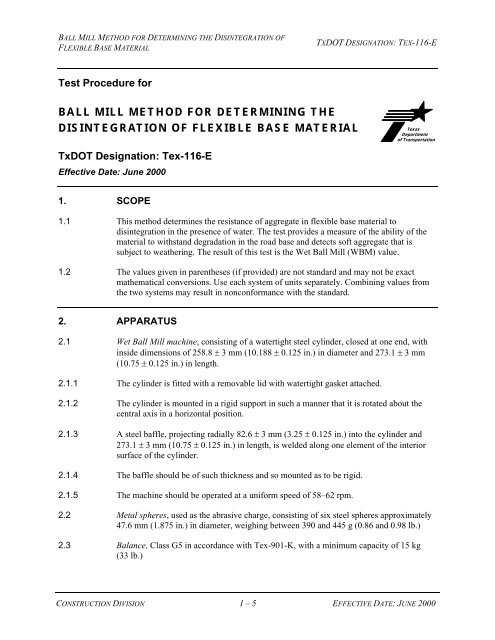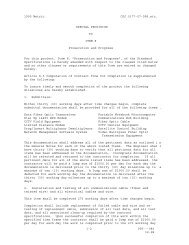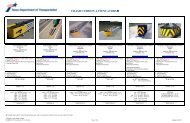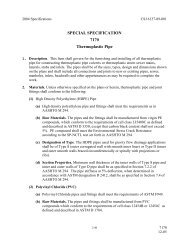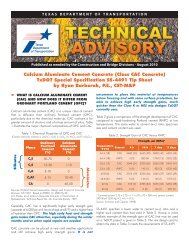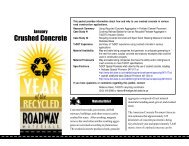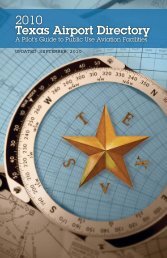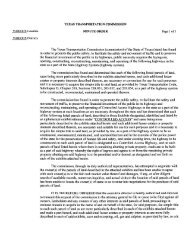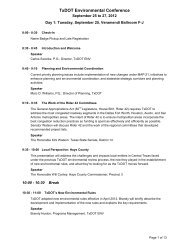BALL MILL METHOD FOR DETERMINING THE DISINTEGRATION ...
BALL MILL METHOD FOR DETERMINING THE DISINTEGRATION ...
BALL MILL METHOD FOR DETERMINING THE DISINTEGRATION ...
Create successful ePaper yourself
Turn your PDF publications into a flip-book with our unique Google optimized e-Paper software.
<strong>BALL</strong> <strong>MILL</strong> <strong>METHOD</strong> <strong>FOR</strong> <strong>DETERMINING</strong> <strong>THE</strong> <strong>DISINTEGRATION</strong> OF<br />
FLEXIBLE BASE MATERIAL<br />
Test Procedure for<br />
<strong>BALL</strong> <strong>MILL</strong> <strong>METHOD</strong> <strong>FOR</strong> <strong>DETERMINING</strong> <strong>THE</strong><br />
<strong>DISINTEGRATION</strong> OF FLEXIBLE BASE MATERIAL<br />
TxDOT Designation: Tex-116-E<br />
Effective Date: June 2000<br />
1. SCOPE<br />
TXDOT DESIGNATION: TEX-116-E<br />
1.1 This method determines the resistance of aggregate in flexible base material to<br />
disintegration in the presence of water. The test provides a measure of the ability of the<br />
material to withstand degradation in the road base and detects soft aggregate that is<br />
subject to weathering. The result of this test is the Wet Ball Mill (WBM) value.<br />
1.2 The values given in parentheses (if provided) are not standard and may not be exact<br />
mathematical conversions. Use each system of units separately. Combining values from<br />
the two systems may result in nonconformance with the standard.<br />
2. APPARATUS<br />
2.1 Wet Ball Mill machine, consisting of a watertight steel cylinder, closed at one end, with<br />
inside dimensions of 258.8 3 mm (10.188 0.125 in.) in diameter and 273.1 3 mm<br />
(10.75 0.125 in.) in length.<br />
2.1.1 The cylinder is fitted with a removable lid with watertight gasket attached.<br />
2.1.2 The cylinder is mounted in a rigid support in such a manner that it is rotated about the<br />
central axis in a horizontal position.<br />
2.1.3 A steel baffle, projecting radially 82.6 3 mm (3.25 0.125 in.) into the cylinder and<br />
273.1 3 mm (10.75 0.125 in.) in length, is welded along one element of the interior<br />
surface of the cylinder.<br />
2.1.4 The baffle should be of such thickness and so mounted as to be rigid.<br />
2.1.5 The machine should be operated at a uniform speed of 58–62 rpm.<br />
Texas<br />
Department<br />
of Transportation<br />
2.2 Metal spheres, used as the abrasive charge, consisting of six steel spheres approximately<br />
47.6 mm (1.875 in.) in diameter, weighing between 390 and 445 g (0.86 and 0.98 lb.)<br />
2.3 Balance, Class G5 in accordance with Tex-901-K, with a minimum capacity of 15 kg<br />
(33 lb.)<br />
CONSTRUCTION DIVISION 1 – 5 EFFECTIVE DATE: JUNE 2000
<strong>BALL</strong> <strong>MILL</strong> <strong>METHOD</strong> <strong>FOR</strong> <strong>DETERMINING</strong> <strong>THE</strong> <strong>DISINTEGRATION</strong> OF<br />
FLEXIBLE BASE MATERIAL<br />
TXDOT DESIGNATION: TEX-116-E<br />
2.4 Standard U.S. sieves, meeting the requirements of Tex-907-K, in the following sizes:<br />
45 mm (1 3/4 in.)<br />
31.5 mm (1 1/4 in.)<br />
22.4 mm (7/8 in.)<br />
16.0 mm (5/8 in.)<br />
9.5 mm (3/8 in.)<br />
4.75 mm (No. 4)<br />
2.00 mm (No. 10)<br />
425 m (No. 40).<br />
2.5 Oven, air-dryer, with temperature set to 60 5C (140 9F).<br />
2.6 Crusher, (optional).<br />
2.7 Miscellaneous equipment, includes large pans, wash bottles, etc.<br />
2.8 Container, 2 L (0.5 gal.)<br />
3. TEST RECORD <strong>FOR</strong>M<br />
3.1 Each sample should be given an identification number and a card bearing the number<br />
should be placed with each portion of the sample throughout the processing and testing of<br />
the material.<br />
PART I—<strong>DETERMINING</strong> <strong>DISINTEGRATION</strong><br />
4. PROCEDURE<br />
4.1 Secure a representative sample of the total material of approximately 12,000 g (26.5 lb.)<br />
4.2 Air-dry the sample at 60C (140F).<br />
4.3 Prepare sample in accordance with Tex-101-E, Part II.<br />
4.4 Recombine a 5000 g (11 lb.) sample for soil constants testing as shown in the governing<br />
specifications if needed.<br />
4.5 Replace oversized particles retained on the 45 mm (1-3/4 in.) sieve with particles passing<br />
the 45 mm (1-3/4 in.) and retained on the 31.5 mm (1-1/4 in.) sieve.<br />
4.6 Recombine a 3500 ± 50 g (7.7 ± 1.1 lb.) air dried sample, weigh to the nearest whole<br />
gram, and record as A under Section 5. Place sample in pan and cover with 2 L (0.5 gal.)<br />
CONSTRUCTION DIVISION 2 – 5 EFFECTIVE DATE: JUNE 2000
<strong>BALL</strong> <strong>MILL</strong> <strong>METHOD</strong> <strong>FOR</strong> <strong>DETERMINING</strong> <strong>THE</strong> <strong>DISINTEGRATION</strong> OF<br />
FLEXIBLE BASE MATERIAL<br />
TXDOT DESIGNATION: TEX-116-E<br />
water for one hour. If 2 L (0.5 gal.) of water do not fully cover the sample, use the<br />
smallest amount of water possible to do so.<br />
Note 1—Use the dry sieve analysis as a rough check for specification compliance for<br />
gradation prior to testing for soil constants and Wet Ball Mill.<br />
4.7 Decant all free water from sample into a 2 L (0.5 gal.) container, finish filling container<br />
with clear water and use to wash sample into the mill.<br />
4.8 Place the six steel spheres in the mill, fasten the watertight lid securely, and rotate<br />
600 revolutions at the uniform speed of 58–62 rpm.<br />
4.9 When the 600 revolutions are completed, remove cover and empty cylinder contents into<br />
a pan.<br />
4.10 Remove the steel spheres and separate the sample by washing over the 425 m (No. 40)<br />
sieve.<br />
4.11 Dry the aggregate portion retained on the 425 m (No. 40) sieve to a constant mass at<br />
60C (140F). Rescreen over the 425 m (No. 40) sieve. Weigh the mass to the nearest<br />
whole gram and record as B under Section 5.<br />
Note 2—Additional sieves may be utilized to determine particle size degradation during<br />
the test.<br />
5. CALCULATIONS<br />
5.1 Calculate the percentage of the soil binder from the Wet Ball Mill test:<br />
Wet Ball Mill Value, WBM 100 ( A B) / A<br />
Where:<br />
A = dry weight of total sample<br />
B = weight of retained material.<br />
PART II—<strong>DETERMINING</strong> INCREASE OF MINUS (-) 425 M (NO. 40)<br />
MATERIAL<br />
6. PROCEDURE<br />
6.1 Recombine approximately 3000 g (6.6 lb.) of the original prepared sample in Section 4.3.<br />
6.2 Weigh to the nearest whole gram and record the mass as C under Section 7.<br />
6.3 Wash the sample over a 425 m (No. 40) sieve.<br />
CONSTRUCTION DIVISION 3 – 5 EFFECTIVE DATE: JUNE 2000
<strong>BALL</strong> <strong>MILL</strong> <strong>METHOD</strong> <strong>FOR</strong> <strong>DETERMINING</strong> <strong>THE</strong> <strong>DISINTEGRATION</strong> OF<br />
FLEXIBLE BASE MATERIAL<br />
TXDOT DESIGNATION: TEX-116-E<br />
6.4 Dry the aggregate portion retained on the 425 m (No. 40) sieve to a constant weight at<br />
60C (140°F). Rescreen over the 425 m (No. 40) sieve and weigh the amount retained<br />
to the nearest whole gram. Record the mass as D under Section 7.<br />
7. CALCULATIONS<br />
7.1 Calculate the original percentage of material passing the 425 m (No. 40) sieve:<br />
Original percentageof min us( ) 425 m( No. 40 ) material 100 ( C D ) / C<br />
Where:<br />
C = original mass of sample<br />
D = mass of material retained on the 425 m (No. 40) sieve.<br />
7.2 Calculate the percent increase of material passing the 425 m (No. 40) sieve:<br />
Percent Increase WBM Original % of min us No.40<br />
8. PRECAUTIONS<br />
8.1 Always use dry material in performing test.<br />
8.2 Avoid the loss of portions of sample in transferring into or out of cylinder.<br />
8.3 Use only 2 L (0.5 gal.) of water to wash the decanted sample into the cylinder.<br />
8.4 Check mass of steel spheres periodically for loss due to wear.<br />
9. REPORTING TEST RESULTS<br />
9.1 Report the Wet Ball Mill value to the nearest whole number.<br />
Note 3—This test furnishes valuable supplementary data pertaining to the quality of the<br />
aggregate portion of flexible base material. The Wet Ball Mill test is more reliable than<br />
the Los Angeles abrasion test in evaluating the quality of base materials.<br />
CONSTRUCTION DIVISION 4 – 5 EFFECTIVE DATE: JUNE 2000
<strong>BALL</strong> <strong>MILL</strong> <strong>METHOD</strong> <strong>FOR</strong> <strong>DETERMINING</strong> <strong>THE</strong> <strong>DISINTEGRATION</strong> OF<br />
FLEXIBLE BASE MATERIAL<br />
TXDOT DESIGNATION: TEX-116-E<br />
Figure 1—Relation Between Percent Soil Binder from Texas Ball Machine and Percent Soil Binder<br />
Before and After Rolling<br />
10. ARCHIVED VERSIONS<br />
10.1 Archived versions are available.<br />
CONSTRUCTION DIVISION 5 – 5 EFFECTIVE DATE: JUNE 2000


